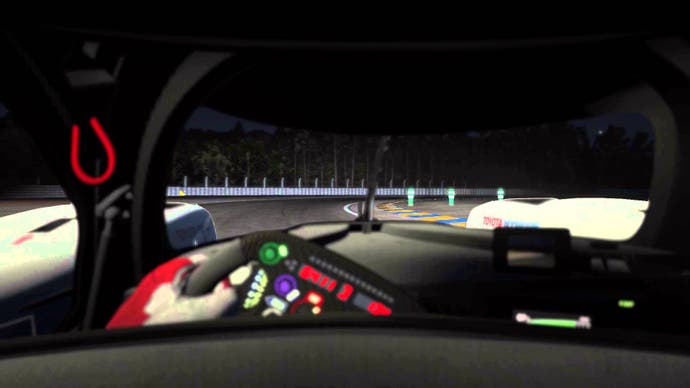Virtual reality's driving force
How one genre stands above all others in VR's new frontiers.
It is, in purely technical terms, a bit of a shit. The left-hander of Surtees climbs slowly uphill, propelling you into the wilderness of Brands Hatch's Grand Prix loop where the delightfully named Pilgrim's Drop and Dingle Dell await. I've never really got the hang of it in any video game, its late apex and rapidly tightening exit proving next to impossible to read, where you're resigned to blindly chopping away at a target that's constantly just out of sight. In most video games, Surtees is a corner that simply doesn't work.
That's until I got to try it in VR. Then, quite suddenly, something that's escaped even the very best simulators clicks. Driving at its purest, and its most efficient, is about simply fixing your gaze somewhere and letting your instincts and reactions figure out the quickest way to get there, and that's so much easier when you can actually turn to look where you're heading. With VR, tackling Surtees is no longer an act of blind faith. Instead, it's a total pleasure.

I've been toying around with VR for a short while now, and I haven't been wholly convinced just yet. There are too many barriers in place at present, from the expense to the space required and through to the fact that so much of it still feels like shallow novelty that can be too easily tossed aside as a faddish distraction. The biggest challenge right now, though, is that VR's still not convincingly figured out the controller problem. PlayStation VR's appropriation of Move and the imminent (and expensive) release of Oculus Touch will help, while Vive's full-body immersion works well enough if you've the space, but there's still an abstraction present in both.

Driving games, though, are enabled by the best controllers around: 1:1 recreations of steering wheels and pedals and, if you're dorky enough, beautiful H-pattern gate shifters. A good force feedback wheel solves VR's control problem with a blunt simplicity. Match a Thrustmaster T500 with an Oculus Rift and you've got one of the best VR experiences around, and you don't have to clear out an entire room to achieve it.
Software support for Oculus Rift has got to the point where you've got plenty of options, some of which fare better than others. Assetto Corsa's support isn't final just yet which makes it a little fiddly, while Dirt Rally's got official support but is also a bit of a pain - I'm having trouble resetting the default view so whenever I drive my head's sticking out of the driver's window like an overenthusiastic, tragically brave dog - and Project Cars is easily the pick of the bunch, with some real thought and care put into its menus and ability to tinker with camera settings.
Get set up and, true to the rest of Project Cars, it looks absolutely stunning. Sitting in the beautifully realised cockpit of the Toyota TS040 for a round the clock blast around Le Mans, I had a bit of a moment as the sun settled over the Mulsanne and I parked up to shed a tear for the noble failures of the Cologne-based WEC team at this cruellest of races, while being careful not to get the huge Nisshinbo capacitor that was in full view damp. Sometimes it's enough to just be taken to the cockpit of these incredible machines and revel in the detail with which they're rendered.

It's also quite fun driving in VR, though, and for that I turn to my more regular poison iRacing which also enjoys good VR support, even if it's not quite as well implemented as in Project Cars. Still, it's easy to get up and running, and once you're in there the detail - and the details you're now free to see - can be breathtaking. Le Mans only recently made its way to iRacing and it is, as far as I'm aware, the first time a laser-scanned version of the track has been made available in a commercially available simulator. That alone makes it worthwhile - and for anyone who's made the pilgrimage to La Sarthe, it can be an emotional experience.
There's the fast food stall beyond the last chicane that kept me going through the small hours, the mound on the inside of Tetre Rouge where I slept under the stars. Out into the wilds of the Mulsanne Straight, I caught a glimpse of quite simply the greatest KFC I've ever seen. Playing in VR is about more than just being able to soak in the fast food chains that find themselves on the periphery of race circuits, though. At Le Mans, it's the tight left hander at Arnage with its treacherously fast curving approach that benefits from a little more freedom with head movement. It's much less terrifying when you're no longer going in blind and can turn to look at the apex you're attempting to nail.
Driving games in VR are nothing short of a revelation, and when matched with a decent steering wheel it's the most convincing case that's been put forward yet for more substantial game experiences. Having spent a couple of months playing them this way, I can't see myself ever going back.

